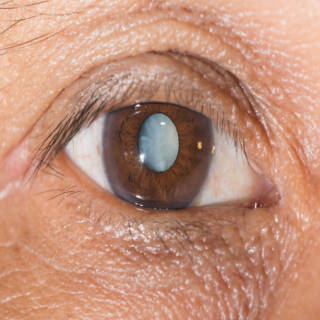Are they a normal part of aging?
You are trying to read the latest book and notice that it is difficult because it feels like you are looking through a fogged-up window. You also realize that it is becoming increasingly challenging to see when you are driving at night. What is going on with your vision? How can you correct this?
 Definition
Definition
Cataracts are when the clear lens that is behind the iris (colored part of your eye) becomes cloudy. The clouding of the lens distorts light as it passes through making it difficult for the light sensing receptors to do their job and this is what makes it difficult to see. Cataracts can be a result of an eye injury, but most often are a natural part of aging because the lens becomes less flexible, less transparent and thicker. The process usually starts small and isn’t noticeable. As it gets larger over time, you can experience vision changes. Typically, you’ll have cataracts in both eyes, but they progress at their own rate. There are several types of cataracts. Nuclear cataracts affect the center of the lens. Cortical cataracts start at the edge of the lens and move inward. Posterior subcapsular cataracts start in the back of the lens, which is directly in the path of light traveling into your eye, so you are more likely to notice vision changes sooner (this type progresses faster than other types). Congenital cataracts occur at birth and can be from genetic conditions, intrauterine infections or trauma (they don’t always affect your vision though).
Symptoms of cataracts include cloudy/blurred/dimmed vision, increasing difficulty seeing at night, sensitivity to light/glare, need for brighter lights to see to read, seeing “halos” around lights, having to frequently change eyeglass or contact lens prescription strength, fading/yellowing of iris and double vision in one eye only. Certain factors can increase your chances of developing cataracts. Some of these factors are increasing age, having diabetes, excessive exposure to sunlight (especially without wearing sunglasses), smoking, obesity, having high blood pressure, having a previous eye injury/inflammation/surgery, prolonged use of corticosteroids and drinking excessive amounts of alcohol.
Treatment
At first, wearing glasses or contacts are usually enough to allow you to see to go about your daily activities. When they are no longer helping, your doctor may recommend surgery. Cataracts don’t harm your eye, so there’s no rush to surgery and waiting to have surgery does not affect the outcome. The surgery involves taking out the clouded lens and replacing it with an artificial one that becomes a permanent part of your eye. If both of your eyes have cataracts, your doctor will do one eye and let that heal completely before doing the other one.
Prevention
While nothing in particular has been discovered to prevent cataracts, there are several things that you can do that might be helpful. The first is to have regular eye exams in order to catch cataracts and other eye conditions at their earliest stages. Don’t smoke and, if you do, quit. Be sure to manage other health conditions, specifically those that are associated with an increased risk of developing cataracts. Eating healthy, especially fruits and vegetables, that provide the nutrients your body needs to maintain good eye health. Avoid excessive amounts of alcohol. Always wear sunglasses when you are going to be outside. Wearing a broad-brimmed hat in addition to sunglasses is also helpful at minimizing glare. Make sure you have plenty of light while reading so you can avoid eye strain.
While cataracts may be a normal part of aging, they can come as a surprise. There are things you can do to prevent the rate at which they grow and the treatment can improve your life dramatically. If you have any questions or concerns, please speak with your doctor. If you would like more information, please visit the American Academy of Ophthalmology’s Cataract page at https://www.aao.org/eye-health/diseases/what-are-cataracts